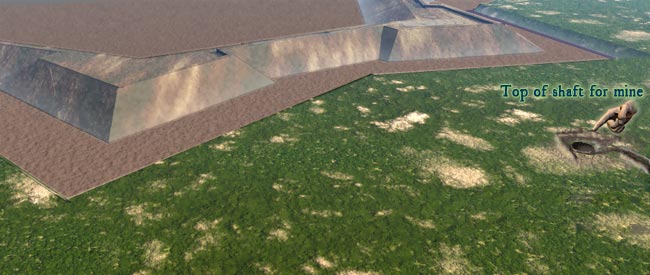 |
Tunneling Out |
The besieged dug countermines as their besiegers dug mines. As the term implies, the intent of countermines was to do something about mining. In addition, countermines were occasionally used to turn the tables on the attackers: defenders burrowed under an artillery position or redoubt and a charge set there to blow that position away.
A countermine's main gallery ran out under the wall from inside the fort (at least the top of that shaft was well shielded) and could have extended to the outside edge of the glacis - or farther if necessary. Differing from mines, countermines had secondary galleries extending out at 90 degrees on both sides of the main gallery, the better to discover an enemy's mine.

Coming out from under the fort were countermines dug by the
defenders. Note the secondary galleries to the sides, the better to find
the enemy's diggings.
Click here to see a countermine (in red), and next click here to see the
attacker's mine (in blue) in relation to the defenders' countermine. Double click
either link to return to the topside view.
In anticipation of future need, countermines were occasionally dug prior to a siege, especially later in the 17th century. John Muller illustrated some forts with pre-siege countermines radiating out in every direction like a starburst. If those countermines were expected to remain passable for months or years, then stone was substituted for wood to hold up the tunnel walls.
Following the capitulation of Grave in 1602, the successful Dutch discovered that the Spanish defenders had anticipated mining of an at-risk bastion: the Spanish had dug a deep hole into the bastion and filled it with water. Had the Dutch dug into it, they would have drowned as their tunnel flooded.
Not surprising, the depth of the countermine was not often the same depth as the mine. If they did not dig right into an enemy's mine, counterminers employed several means of detecting any enemy digging.
Inside a confined world lit only by candles and oil lamps, sight was of little use for finding the enemy; his gallery might have been less than half a meter away and nothing was seen. Ears became excellent replacements for eyes. Diggers stopped periodically to listen carefully for sounds of someone else's shovels and picks - or talk. Behind the diggers, in already finished portions of a gallery, little bells were sometimes hung on ceilings and walls could make audible slight vibrations made by other diggers, or dried peas set atop a drumhead. Long iron needles or augers were inserted into the walls, floor and ceilings at intervals. Should resistance suddenly fall off for a probing needle, then an air space was found. Where there was an air space, there was most likely another mine.
What was good for the goose was good for the gander. Those in a countermine could place a powder charge next to where they detected an enemy mine and blow the other miners farther down to hell.
Or, once another mine was detected very close by, miners scooped out a small hole. An opening was made into the enemy gallery and hand grenades were tossed in or a pistol stuck through and fired. The hole may have been enlarged enough so that soldiers and miners of one side could crawl into the enemy mine and there get into a close-quarter fight. Of course that also occurred should one gallery have broken into another during digging.
Besieging miners also employed these very techniques against countermines. Invisible to those up on the parapets and down in the surrounding trenches, hard work and desperate fights took place that decided the fates of all.